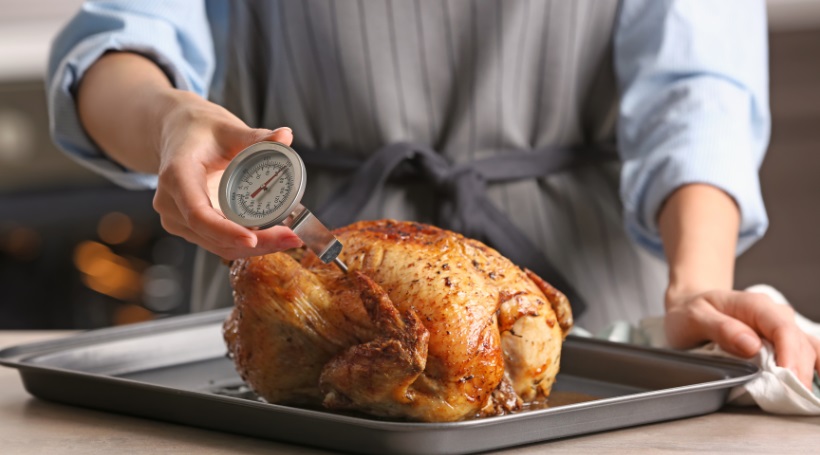Last Updated on January 1, 2025
The safe temperature for cooking chicken is 165°F (74°C). This ensures harmful bacteria are destroyed.
Cooking chicken to the right temperature is crucial for food safety. Undercooked chicken can harbor dangerous bacteria like Salmonella and Campylobacter. These pathogens can cause severe foodborne illnesses. Using a meat thermometer helps in achieving the perfect temperature. Insert it into the thickest part of the chicken, avoiding bones.
This method ensures the entire piece is cooked thoroughly. Besides safety, proper cooking enhances the flavor and texture of chicken. Overcooking, on the other hand, can make it dry and unpalatable. Achieving the right balance ensures a delicious and safe meal. For the best results, always prioritize reaching 165°F when cooking chicken.
Safe Cooking Temperatures
Cooking chicken safely is crucial to avoid foodborne illnesses. Knowing the right temperature ensures your chicken is both delicious and safe to eat. Let’s dive into the key points about safe cooking temperatures for chicken.
Ideal Internal Temperature
The ideal internal temperature for cooked chicken is 165°F (75°C). Use a meat thermometer to check the temperature. Insert it into the thickest part of the chicken. Make sure the thermometer does not touch bone.
| Chicken Part | Internal Temperature |
|---|---|
| Whole Chicken | 165°F (75°C) |
| Chicken Breasts | 165°F (75°C) |
| Chicken Thighs | 165°F (75°C) |
Cooking chicken to the right temperature kills harmful bacteria. Ensure the chicken is safe to eat. This applies to all parts of the chicken, including breasts, thighs, wings, and drumsticks.
Importance Of Temperature
Temperature is key in cooking chicken safely. High enough heat kills harmful bacteria like Salmonella and Campylobacter. These bacteria can cause serious illness.
- Raw chicken often contains harmful bacteria.
- Cooking at 165°F (75°C) ensures bacteria are killed.
- Undercooked chicken may lead to food poisoning.
Using a meat thermometer is the best way to ensure chicken is cooked properly. A thermometer gives a precise reading. This is better than guessing or relying on the color of the meat.
Remember, safe cooking temperatures are vital for healthy eating. Always ensure your chicken reaches the ideal internal temperature. Enjoy your meal with peace of mind.

Measuring Chicken Temperature
Ensuring that chicken is cooked to a safe temperature is crucial. This prevents foodborne illnesses. One way to do this is by measuring the chicken’s temperature accurately.
Types Of Thermometers
There are various types of thermometers available for cooking. Each type has its own unique features.
- Digital Instant-Read Thermometers: Provide quick and accurate readings.
- Dial Oven-Safe Thermometers: Can stay in the meat while it cooks.
- Probe Thermometers: Ideal for continuous monitoring.
- Thermocouple Thermometers: Offer the fastest readings.
Proper Usage
Using a thermometer correctly ensures accurate temperature readings. Follow these steps to use a thermometer properly:
- Insert the thermometer into the thickest part of the chicken.
- Avoid bones, as they can give false readings.
- Wait for the thermometer to stabilize before reading.
- Ensure the chicken reaches an internal temperature of 165°F (75°C).
| Thermometer Type | Usage Tips |
|---|---|
| Digital Instant-Read | Insert at the end of cooking for a quick check. |
| Dial Oven-Safe | Leave in the chicken throughout cooking. |
| Probe Thermometers | Monitor temperature without opening the oven. |
| Thermocouple | Use for the fastest and most accurate readings. |
By following these guidelines, you can ensure your chicken is cooked safely. This helps protect your family from potential foodborne illnesses.
Risks Of Undercooked Chicken
Cooking chicken to the correct temperature is crucial. Undercooked chicken can lead to serious health issues. The risks are not worth taking. To keep your family safe, understanding these risks is key.
Foodborne Illnesses
Undercooked chicken is a common source of foodborne illnesses. It can contain harmful bacteria. These bacteria include Salmonella and Campylobacter. These can cause severe health problems.
Even a small bite of undercooked chicken can be dangerous. The bacteria can spread quickly in your body. This may lead to food poisoning. Keeping your chicken fully cooked can prevent this.
Symptoms To Watch For
Symptoms of foodborne illness can vary. They often start within hours of eating. Common symptoms include:
- Nausea
- Vomiting
- Diarrhea
- Abdominal pain
Severe symptoms may include:
- High fever
- Chills
- Dehydration
- Bloody stools
If you experience these symptoms, seek medical help. It’s important to act quickly. Early treatment can reduce the severity of the illness.

Cooking Methods
Cooking chicken safely is crucial. Different methods require different approaches. Let’s explore the best practices for cooking chicken using various methods.
Oven Cooking
Oven cooking is a popular method. Preheat your oven to 375°F (190°C). Place the chicken on a baking sheet. Make sure the chicken pieces do not touch. This ensures even cooking.
Use a meat thermometer. Insert it into the thickest part of the chicken. The safe internal temperature is 165°F (74°C). This ensures the chicken is safe to eat. The table below shows recommended cooking times:
| Chicken Cut | Cooking Time |
|---|---|
| Whole Chicken | 1.5 to 2 hours |
| Boneless Breast | 20 to 30 minutes |
| Bone-in Thighs | 35 to 45 minutes |
Grilling And Bbq
Grilling and BBQ methods add a smoky flavor. Preheat the grill to medium-high heat. Lightly oil the grill grates. Place the chicken on the grill. Cook with the lid closed. This keeps the heat consistent.
- Grill chicken breasts for 6-8 minutes per side.
- Cook drumsticks for 10-12 minutes per side.
- Grill wings for 8-10 minutes per side.
Always use a meat thermometer. Check the thickest part of the chicken. The internal temperature should be 165°F (74°C). This ensures the chicken is fully cooked.
Tips For Juicy Chicken
Cooking chicken to the perfect temperature is important. It ensures safety and taste. Here are some tips to keep your chicken juicy and flavorful. Follow these steps to make your chicken tender and delicious.
Marinating Techniques
Marinating chicken helps to keep it moist. Use a mix of oil, acid, and spices. This makes the chicken tender and flavorful.
- Oil: Olive oil or vegetable oil works well.
- Acid: Use lemon juice, vinegar, or yogurt.
- Spices: Garlic, herbs, and pepper add great taste.
Marinate the chicken for at least 30 minutes. For best results, marinate overnight in the fridge.
Resting After Cooking
After cooking, let the chicken rest. This step is crucial. It allows the juices to redistribute.
Place the cooked chicken on a plate. Cover it with foil. Let it rest for at least 10 minutes. This helps keep the chicken juicy.
| Step | Details |
|---|---|
| Marinate | At least 30 minutes, overnight for best results |
| Rest | At least 10 minutes after cooking |

Frequently Asked Questions
What Is The Safe Temperature For Chicken?
The safe temperature for cooking chicken is 165°F (75°C) to ensure harmful bacteria are killed.
How To Check Chicken Temperature?
Use a meat thermometer to check the thickest part of the chicken, avoiding bones.
Why Cook Chicken To 165°f?
Cooking chicken to 165°F ensures that harmful bacteria like Salmonella are destroyed.
Can You Eat Chicken At 160°f?
Chicken should be cooked to 165°F for safety, not 160°F, to kill all bacteria.
What Happens If Chicken Is Undercooked?
Undercooked chicken can cause food poisoning due to bacteria like Salmonella and Campylobacter.
Conclusion
Cooking chicken safely is crucial to avoid foodborne illnesses. Ensure the internal temperature reaches 165°F. Use a food thermometer for accuracy. Proper cooking ensures your chicken is both delicious and safe. Remember, safety first in the kitchen. Enjoy your perfectly cooked chicken Goku every time!

